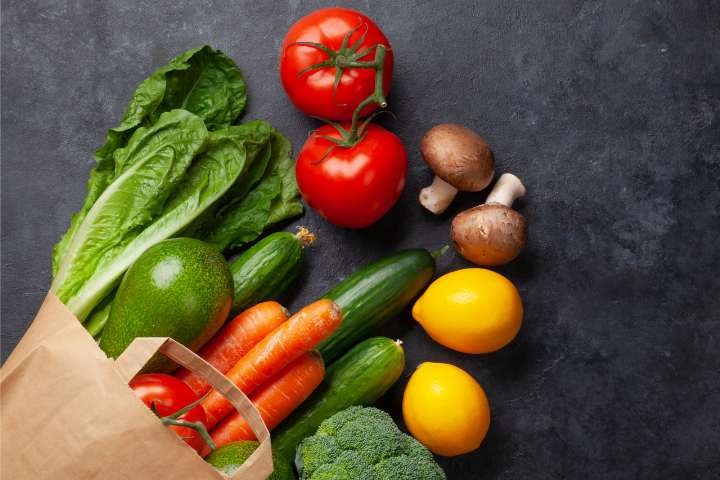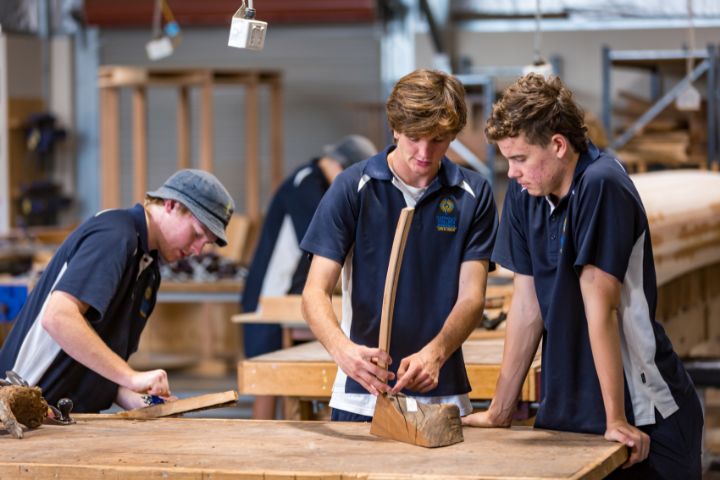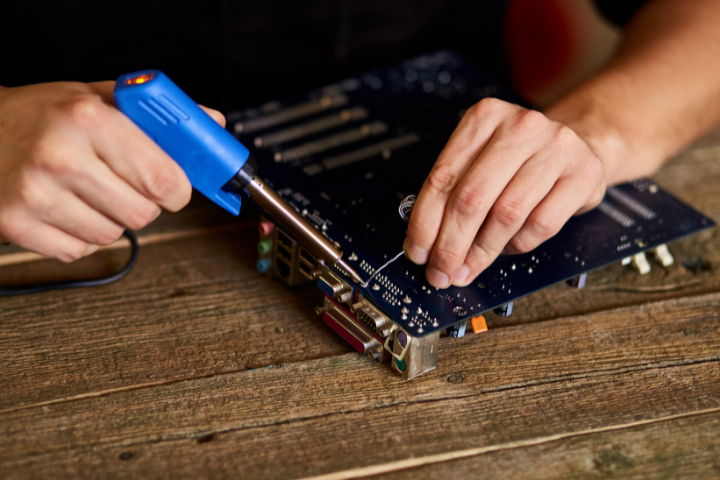TECHNOLOGY DOMAIN
Deeane Cordy
Technology Instructional Leader
Learning in the Technology Domain gives you the freedom to use your creativity to solve problems in a real-world context.
Technology is an increasingly significant part of our society, which is why it is important that we learn the appliances and systems people rely on daily in order to create a more efficient, safer and healthier world.
We foster an appreciation for traditional techniques, while also exploring the frenetic world of emerging technologies. Here, you have opportunities to analyse problems and implement a range of digital and design solutions such as artificial intelligence engines, engineering robots, building sustainable furniture and improving the quality and accessibility of food.
In this Domain you have the choice to explore technologies in the areas of; digital, fibre, food, materials and systems engineering.
Food Studies 3-4

- Does media, technology and advertising influence our eating habits?
- Investigate how food can nourish and sometimes harm us
- Identify challenges in feeding a rising world population
Subject Code: V2TFS
Year Level: 12
Unit 3: Food in daily life
You look at the science of food: our physical needs, how food nourishes and sometimes harms our bodies. Analyse intolerances, allergies, digestion, food contamination and use of food selection models. You study influences on food choice: how communities, families and individuals change their eating patterns as well as explaining behavioural principles behind establishing healthy meal patterns. Use practical skills to create healthy meals for families.
Assessment
- School assessed coursework (2): a range of practical activities related to nutritious food/dietary needs and other written assessed tasks e.g. media analysis, case study, responses to infographics
- Unit 3 work contributes to end of year exam
Unit 4: Food issues challenges and futures
You debate global and Australian food systems relating to issues about the environment, ecology, ethics, farming practices, the development and application of technologies, and the challenges of food security (challenge of adequately feeding a rising world population), food safety, food wastage, and the use and management of water and land.
You become consumers who make discerning food choices. Identify fads, trends and diets. Interpret food labels and marketing terms used on food packaging.
Assessment
- A range of practical activities and completion of two records regarding healthy food choices based on recommendations of the Australian Dietary Guidelines
- Research inquiry report on a selected food-related topic regarding concerns about ethics or sustainability of ecology (food sovereignty)
- End of year exam (Unit 3 and 4)
- School assessed coursework for Unit 3 and 4, each unit contributes 30 per cent = 60% plus exam = 40%
What sort of student would like Food Studies?
Someone who:
- Is interested in foods
- Likes analysing what happens during cooking, digestion and using a variety of preparation methods
- Is curious about sustainable and ethical food issues, healthy eating, meal creation and nutrition.
Pre-requisites
Food Studies Units 1-2 recommended.
Other considerations
This unit has a wide theoretical base and therefore makes up around 50% - 60% of total class time. The other 50-40% is practical based (testing and tasting foods and/or producing recipes).
Product Design and Technologies 3-4

- Design and build your own major project
- Challenge yourself in a collaborative and practical environment
- Expand on your previous learning and attained skills
Subject Code: V2TPD
Year Level: 12
Unit 3: Ethical product design and development
Our class investigates and defines a design problem, and discusses how the design process leads to ethical product design development. We explain and analyse influences on the design, development and manufacture of products within industrial settings. You document the product design process used to meet the needs of an end-user/s, and commence production of the designed product.
Assessment
- Structured, annotated design brief, evaluation criteria to the intended product
- Well presented and managed design folio
- Record of research and planning of the intended project, and documentation of modifications
Unit 4: Product and evaluation of ethical designs
We compare, analyse and evaluate similar commercial products, taking into account a range of factors and using appropriate techniques. You apply production skills and processes safely to make the product designed in Unit 3. You manage time and resources effectively and efficiently. We evaluate the finished product through testing and feedback against criteria, create end-user/s’ instructions or care labels and recommend improvements to future products.
Assessment
- Completion of a functional product that conforms to standards of quality indicated in the design brief
- Written report and product evaluation
- End-user/s instructions
What sort of student would like Product Design and Technology?
Someone who:
- Is interested in designing and making products
- Likes working with wood and metals
- Would like to follow a building, engineering or designing career
- Would like to pursue tertiary qualifications in building, engineering or designing careers.
Pre-requisites
Any Pathways subjects in Materials Technology in Timber or Metal.
Systems Engineering 3-4

- Design and create your own mechanical-electro technology integrated and controlled system
- Learn about renewable energy sources
- Investigate new and emerging technologies
Subject Code: V2TSE
Year Level: 12
Unit 3
Our focus is on the engineering principles used to explain the physical properties of integrated systems and how they work. We design and plan an operational, mechanical-electro technology integrated and controlled system. You learn about the technologies used to harness energy sources to provide power for engineered systems, including renewable energy.
What does this mean for me?
You start work on the design, planning and construction of one substantial controlled integrated system. You manage the project through the systems engineering process, taking into consideration the factors that influence the design, planning, production and use of their integrated system.
Assessment
- Written tests
- SAC – Clean Energy Technologies
- SAT – Designing and Planning Design folio
Unit 4
You complete the production work and test and evaluate the integrated control system you designed in Unit 3. We investigate new and emerging technologies, consider reasons for their development and analyse their impacts.
What does this mean for me?
You use your investigations, design and planning to continue the fabrication of your mechanical-electro technology integrated and controlled system using the Systems Engineering process. We draw upon project and risk management methods throughout the construction phase.
Assessment
- Written tests
- SAC – New and Emerging Technologies
- SAT – Construction, Diagnostic Testing and Evaluation from design folio
- end of semester exam
What sort of student would like Systems Engineering?
Someone who:
- Is looking for a sound basis for entry into a broad range of tertiary technology courses such as; engineering and applied sciences, skilled trades and vocational training, in the electro technology and automotive sectors
- Interested in gaining employment in technological enterprises.
Pre-requisites
Physics or electronics-based subjects such as Our Chemical and Physical World would be beneficial. Pathways subjects - Remote Controlled Vehicle, 3D Design and Construction, Robotics.
Other considerations
A subject that complements Systems Engineering is Physics.
